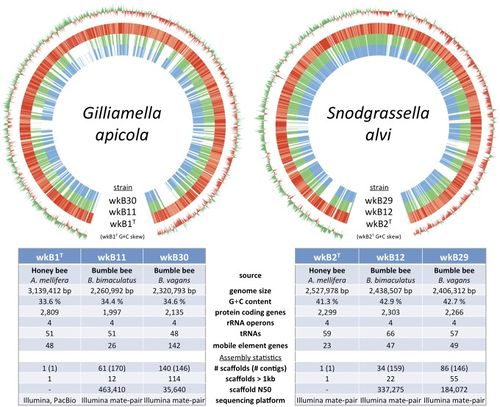Snodgrassella alvi wkB2
Classification
Taxonomy
Domain: Bacteria
Phylum: Proteobacteria
Class: Betaproteobacteria
Order: Neisseriales
Family: Neisseriaceae
Genus: Snodgrassella
Species: alvi
Strain: wkB2
|
NCBI: Taxonomy |
Names
Snodgrassella alvi wkB2
Candidatus Snodgrassella alvi wkB2
S. alvi wkB2
Description and Significance
S. alvi is a core member of the western honey bee ( Apis mellifera ) gut microbiota.
Genome Structure
Describe the size and content of the genome. How many chromosomes? Circular or linear? Other interesting features? What is known about its sequence?
The genome of S. alvi wkB2 consists of a singular circular chromosome containing 2,527,978 bp (Kwong 2014). GENES?? Of these genes, 2,299 of them code for proteins. The G+C content is 41.3% (Kwong 2014).
Cell Structure, Metabolism and Life Cycle
Interesting features of cell structure; how it gains energy; what important molecules it produces.
Cell Structure
Metabolism
S. alvi wkB2 is an obligate aerobe. S. alvi wkB2 has transportation systems for taking up carboxylates like citrate, malate, & α-ketoclutarate. These can then be used in the TAC cycle. Transportation systems within S. alvi wkB2 can also allow for the uptake of lactate which can be directly converted into pyruvate through lactate dehydrogenase.
Lost Metabolic Pathways
Evidence has been found suggesting that S. alvi was able to take up and break down carbohydrates, but has since lost that ability (Kwong 2014). The Glycolosis pathway, Pentose phosphate pathway, & Entner-Doudoroff pathway have all lost essential enzymes (Kwong 2014). These pathways are typically used to convert sugars to pyruvate.
Life Cycle
Ecology
Habitat; symbiosis; biogeochemical significance; contributions to environment.
If relevant, how does this organism cause disease? Human, animal, plant hosts? Virulence factors, as well as patient symptoms.
References
Author
Page authored by Samantha Worthington, student of Prof. Jay Lennon at Indiana University.

